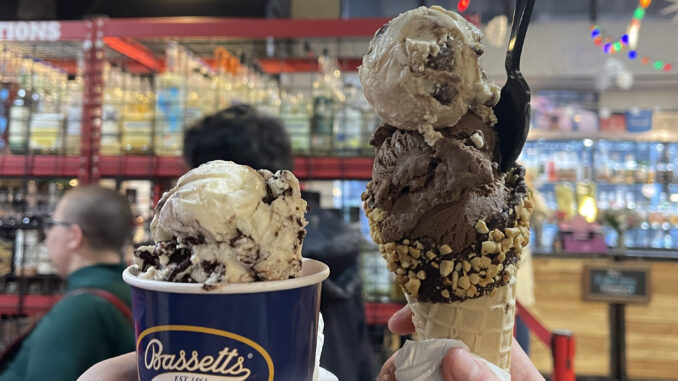
Emma Polen | Editor-in-Chief
I recently visited Philadelphia’s Reading Terminal Market, a culturally-diverse food oasis in the city’s center – something that Pittsburgh does not have.
What I noticed first, as I weaved in and out of the overwhelming number of stalls from one end of the train station-turned-food-hub to the other, was there was not a single chain restaurant in sight (unless my Pittsburgh eyes were just untrained for the Philly regional cuisine).
Reading Terminal featured seemingly endless booths of locally owned businesses, including made-to-order Mediterranean and Middle Eastern cuisine, and fresh-cut meats, cheeses, seafood and baked goods. Whether you had dietary restrictions or just had a taste for a specific variety of fish, they had it in this indoor marketplace – a proud cut of Philly’s culture that I haven’t seen in the area before but which exists in nearly every major city of Europe.
In Rome, there’s an indoor food market called Mercato Centrale. This marketplace has four locations across Italy, and each differs in regional specialties. The one in Rome hosted cacio e pepe, the Italian version of mac ‘n cheese, a meat counter with Trippa alla Romana, a specific way of preparing animal tripe and maritozzi, a cream-filled brioche bun Rome is famous for. With all of these offerings, there was a chance to try the best of the local cuisine without having to travel across the entire city for a taste of everything. And through it all, you could be certain you were supporting local business.
Versailles’ Place du Marché Notre Dame compound is reminiscent of an Amish market with cheeses, fudge, fresh baked goods, and every type of wild honey for sale. But a weary traveler has to travel no further than the next booth over to try a different taste of France’s regional menu.
The Keystone State has its own variety of cultural food markets. Harrisburg already has the Broadstreet Market, Philadelphia has Reading Terminal, so where’s our indoor hub for local fresh goods and cuisine? Lancaster Central Market, while markedly not located in a large city, hosts a number of local vendors in a continuously-running farmers market.
In Pittsburgh, there is no shortage of food culture variety, they’re just not all available in the same place.
Every spring, local international nonprofit Literacy Pittsburgh showcases the numerous countries that have brought their own taste of home to the region with a one-night collage of culture inside Stage AE. Their International Food Fair tables over 50 food and hand-crafting vendors from all over the world, who offer their goods at Pittsburgh storefronts, seasonal pop-ups or websites online.
So, here’s proof that international cookery is thriving in the Pittsburgh area.
You might know how to get to Strip District Meats butchery, Enrico’s Italian Biscotti or Chicken Latino from Peru. But what if there was a place where all of these special dining locations were on display, equidistant to each other under one shared roof?
When my family invites people to stay with us for the holidays, we take them to some of our favorite Pittsburgh spots: Phipps Botanical Garden, the Carnegie Museum of Art and Natural History and then an eat-out spot, too.
But, as the city is currently laid out, we have to go with just one regional cuisine. Maybe we take them to Smallman Street Deli to try a stacked Pittsburgh sandwich, or to Talia’s Italian cuisine downtown. But there’s no opportunity to try it all in our limited time together, and we (and our guests) are missing out. And as an individual who appreciates the chance to try anything and everything, a one-stop, multicultural food center would satisfy that need to have a taste of Pittsburgh’s best.
Pittsburgh has enough chain food stops. There’s five Starbucks within two miles of each other just up the road from campus on McKnight Road, with not a single locally-owned, brick-and-mortar café in those same limits. What we need, what would boost local business, would be a permanent promise of cultural food diversity all in one spot – not an annual summer produce market, not a seasonal flea market inside a parking garage, but a place that reliably hosted Pittsburgh’s proud list of diverse local-owned businesses year-round.
